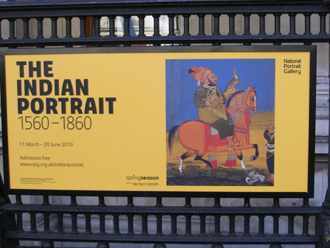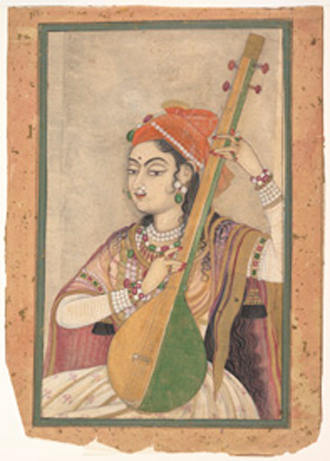The Indian Portrait 1560-1860 National Portrait Gallery, London – 11 March to 20 June 2010
7. 5. 2010 | Rubriky: Articles,Feature
 [by Ken Hunt, London] London’s National Portrait Gallery is currently offering two marvellous exhibitions of Indian art. Admission is free and while they may not appear to cast much light of the subcontinent’s musical arts, amid the huqqa smokers, the military figures, nobility and royalty, there are a few correlations between Indian portraiture and aspects of the subcontinent’s music to interest the musically minded.
[by Ken Hunt, London] London’s National Portrait Gallery is currently offering two marvellous exhibitions of Indian art. Admission is free and while they may not appear to cast much light of the subcontinent’s musical arts, amid the huqqa smokers, the military figures, nobility and royalty, there are a few correlations between Indian portraiture and aspects of the subcontinent’s music to interest the musically minded.
The Indian Portrait 1560-1860 draws on works from successive Mughal courts, from an era when patronage – sponsorship in the modern arts vernacular – was keen to log its movements in an era before photography. Amid the portraiture of personages and merchants from Rajasthan, Gwalior and elsewhere in poses with blade and blossom or the courtesans at leisure, three images stand out.
One entitled ‘The vina player Naubat Khan Kalawant’, in fact turns out to be unnamed on the portrait, although the exhibitors or art historians have deduced him probably to be Misri Singh, “a Rajasthani musicians at Akbar’s court who was given the title Naubat Khan” on the basis of him being in charge of the naubatkhani – from the context the gateway above which music was played. He is captured in a stylised setting of plants and small birds rather than any palatial or urban backdrop. His portrait is attributed to Mansur (cryptically “the work of the designer Mansur”) and dated to circa 1590-95. The image is fascinating. He appears to be playing the vina – the two gourds of which are brightly decorated in blue, crimson and gold – but not in the customary seated position as we became accustomed to seeing in the second half of the twentieth century. Instead he looks like a travelling bard and is depicted standing as musicians were later depicted in postcards from the first half of the twentieth century. In picture postcards of nautch (courtesan) entertainers, for example, sarangi players are often depicted standing with the instrument braced against a waist pouch. Interestingly, there appears to be a deliberate attempt to capture Naubat Khan Kalawant’s features as an individual, not as a cipher.
 This is in contrast to the Rajasthani portrait called ‘A lady playing a tanpura’ from around 1735 “in ink, gold, opaque and transparent watercolour on paper”. She is unidentified, her features a cipher of the Indian Everywoman. The portrait is all the better for that. Her hair is long and cascades from beneath a bejewelled and pearled turban. She holds her five-stringed tanpura upright (only four tuning pegs are visible). This way she stands for generations of anonymous musicians or nautch entertainers whose features and names are long forgotten. It is on loan from the Metropolitan Museum of Art, Fletcher Fund. It is a real find. It is available as a postcard.
This is in contrast to the Rajasthani portrait called ‘A lady playing a tanpura’ from around 1735 “in ink, gold, opaque and transparent watercolour on paper”. She is unidentified, her features a cipher of the Indian Everywoman. The portrait is all the better for that. Her hair is long and cascades from beneath a bejewelled and pearled turban. She holds her five-stringed tanpura upright (only four tuning pegs are visible). This way she stands for generations of anonymous musicians or nautch entertainers whose features and names are long forgotten. It is on loan from the Metropolitan Museum of Art, Fletcher Fund. It is a real find. It is available as a postcard.
Her anonymity is in marked contrast to a portrait of courtesans shown off-duty, loaned from the San Diego Museum of Art, Edwin Binney 3rd Collection. ‘A group of courtesans’, stated to be from Delhi around 1820, depicts six recognisable individuals, perhaps even favourites, with different skin hues, different styles of clothing. The portrait is exquisite and in its detail it casts light on an aspect of culture. Until historical times, most musicians in the subcontinent were faceless. They might play for royalty, the elite and the moneyed but they ate with the servants.
More information at www.npg.org.uk/whatson/exhibitions/the-indian-portrait-1560-1860.php